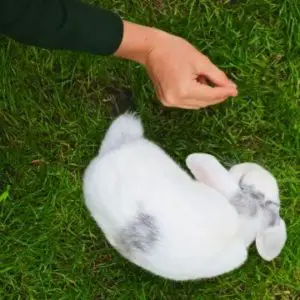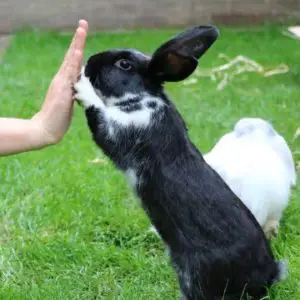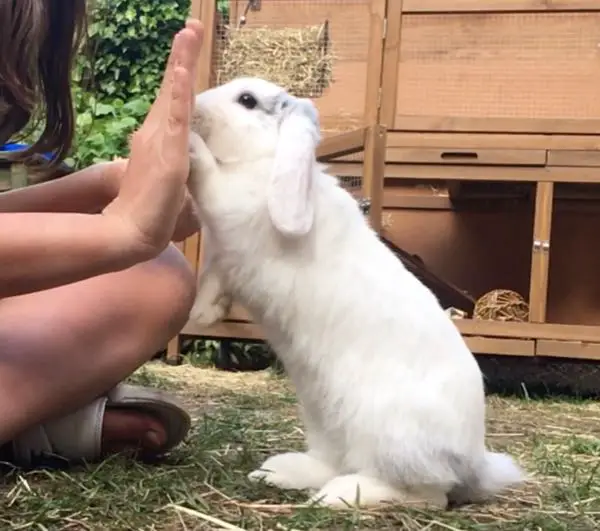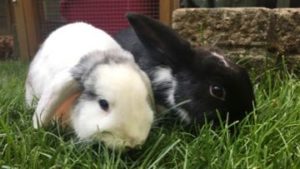Introduction
We love our bunnies and their different, inquisitive personalities. It’s great to watch them play or bink. We were delighted when we brought home Fish and Chips, and watched them explore the garden, noses twitching. They soon learned all the hiding holes and corners.
But a new garden layout isn’t the only thing that rabbits can learn. Our bright-eyed bunnies are learning to give high fives, and to spin around. Teaching them the tricks also helps bond you and your rabbits more closely. Read on to find out how we went about it.
Here is how I am teaching my rabbits to do tricks – in particular, how to train your rabbit to spin around following your finger, and how to teach your bunny to high five.
First of all, I want to say that the same methods won’t necessarily work for every bunny, and for some rabbits it might take longer to learn – you just need a bit of patience. Mine only take a few days to learn a trick, but you have to keep it up so that they don’t forget!
Where to practise
First of all get your rabbits in a space where they won’t be too distracted and have enough room. I just do it on the grass in my garden because the treats in my hand are enough to ensure they aren’t distracted by everything around them.
You probably need to get on their level by sitting in front of them – just to make it easier.
What you need
Get some treats for your rabbits in a bowl or cup near you (make sure they are out of the bunnies’ reach!). They don’t need to be your rabbits’ favourite treats – mine will do the trick for one pellet (but some rabbits may be different – they all have their own personalities, don’t they!). Make sure that you have enough as you don’t want to run out. At the start of learning a trick, it is important that you reward them every time they do it.
How to train your rabbit to spin around
- Using a treat, guide your rabbit to spin around in a circle. You may have to do this quite slowly so they aren’t confused. Hold the treat in front of them, and circle it around their back as they follow it, and end up doing a 360o turn trying to get the treat.
- Once they have turned all the way around, give them the treat!
- You keep doing this so that they get the idea of the movement in their head, and that they link doing this to getting a treat. Fish learned this a little quicker than Chips, but they both made the link fairly quickly.
- They will start to get slightly faster at doing the movement/trick.
-

Fish demonstrating how to spin around
Once you feel that your rabbit understands what they are doing, change your gesture with the treat slightly. For example, make your circle motion with the treat a little faster, or make a smaller circle.
- Keep altering your gesture until you are happy with the one that you want to use when you want them to do the trick.
- Then, for a few days, keep using this gesture and giving them a pellet or treat when they do the trick.
- Once they are doing this regularly, and you have confidence in them, you can do the gesture without a treat in your hand. Still give one to them after they have done it, for a couple of days.
- This next step is important – don’t miss it out! Next, you do the trick completely without any treat, but occasionally give them treats anyway, so that they know it is still good to perform the movement. It will help make sure that your bunny remembers and keeps performing the trick!
Now you have taught your clever bunny a fantastic trick – they will spin around with your finger.
Remember to keep training sessions short, and don’t let your bunnies become tired or frustrated. It should always be fun.
How to teach your rabbit to high five
- Hold a treat in your hand, and offer your palm upright to your bunny. She will come up to the palm to get it.
- Next, lift your palm a bit higher off the ground. Your bunny will then reach up, and place her paws on your palm to balance and get the treat. Again, do this a few times, so they link putting their paws on your hand with the treat.
- Soon, your bunny will place their paws on your palm without a treat – at this early stage still reward them with a treat straight away after they have placed their paw on your hand. Chips took a little longer to reach this stage – every bunny is different!
-

Chips learned to high five too!
Just like teaching your bunny to spin, you now offer your palm for them to high five you, but occasionally give them a treat as a reward – not every time. Doing this will help your bunny to learn faster and to keep high fiving you for longer.
- Now you should be able to offer your palm, and your bunny will high five you.
And remember – sessions should be fun for you and the rabbits. Keep the sessions short, and don’t frustrate your bunnies.
What other tricks will this work for?
You can use the same principles to get your bunny to perform other tricks. For example, some people train their bunnies to come when they call their name. Others train them to jump on cue (or even to jump through hoops…).
Give them treats when they perform the action you want, so they link the action and the treat. Reinforce this link. Start varying how often you reward the action.
Just make sure that the trick is fun and safe for the rabbit to perform.
Why it works
This is only for those curious to know a little bit about why this method works – otherwise scroll on past.
Teaching your rabbits this way is using something psychologists call variable ratio reinforcement method of operant conditioning – but the name hides a process that we are all familiar with.
Operant conditioning (first coined by the behavioural psychologist Skinner) simply means that animals (and us) can learn to associate things they do with what happens next (behaviour and response). If what happens next is good, we do more of it. If what happens next isn’t, we do it less. If it keeps happening, this reinforces our behaviour.
But what is ‘variable ratio reinforcement’? Well, there are different ways we could choose to reward our rabbits. We could do it every time, or do it regularly (say, every five minutes during training), or vary the time between rewards.
But none of these is as effective as varying randomly how many times the trick is performed before another treat – this is variable ratio reinforcement.
And this approach, over a wide range of behaviour (not just in rabbits), gets the fastest, most frequent response, and the effects last the longest. Find out more here.

We humans respond to rewards too
Have you ever seen a jackpot machine? (Some places call them ‘one-armed bandits’ and others ‘slot machines’).
You put in a coin, pull the lever (or press the button), and occasionally get a reward of a shower of coins.
The more coins you feed in, the more level pulls you get, and the more likely you are to get a jackpot (but you still ending up putting more money than you win…).
It’s using the same principle, and it earns money for casinos all over the world.
In the same way, a good game will provide enough challenge that we don’t succeed every time, but have to try a few times to get the reward of completing a level.
Operant conditioning works on us, and it works on bunnies.
Conclusion
Teaching your rabbit to spin around or give you a high five is a fun way to spend time with your bunnies. It keeps them active, helps bonding, and (let’s be honest) it’s pretty cool to see our cute friends able to learn these tricks. Rewarding your bunnies motivates them to learn and show off their abilities. Have fun with your furry friends!
If you enjoy teaching your bunny tricks, you probably also enjoy getting a fantastic photo of your rabbit. Have a look at our article on getting the best pictures of your bunnies.
Fish and Chips enjoy tricks, but even they can’t do as much as cartoon film star Roger Rabbit. But what breed of rabbit was he, you ask? We explore the possibilities in this post.


